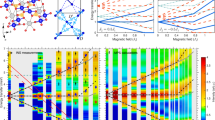Abstract:
CuGeO3 exhibits a Spin-Peierls (SP) transition, at T SP = 14.3 K, which is announced above 19 K by an important regime of one-dimensional (1D) pretransitional lattice fluctuations which can be detected until about 40 K using X-ray diffuse scattering investigations. A quantitative analysis of this scattering shows that in this 1D direction the correlation length follows the “universal” behaviour expected for the thermal fluctuations of a real order parameter which characterizes the lattice dimerization. This allows to define a 1D mean-field temperature, T SP MF, of about 60 K and invalidates any mean field scenario for the SP transition of CuGeO3. As T SP MF is as high as 4 T SP we propose that the 3D-SP order is achieved by the interchain coupling between 1D solitons which form below about 16-20 K. CuGeO3 being in the non-adiabatic regime, it is also suggested that the observed pretransitional fluctuations of CuGeO3 originate from the X-ray scattering on a very broad damped critical response of lower frequency than the “critical” phonon modes. From the quantitative analysis of the 1D fluctuations we also estimate the microscopic parameters of the SP chain. These parameters allow to locate CuGeO3 close to the quantum critical boundary separating the gapped SP ground state to the ungapped anti-ferromagnetic ground state. The vicinity of a quantum critical point emphasizes the role of the quantum and non-adiabatic fluctuations and the importance of the interchain coupling in the physics of CuGeO3. Finally we compare these findings with those obtained for the organic SP systems (BCPTTF)2PF6, (TMTTF)2PF6 and MEM(TCNQ)2. From a similar analysis of the pretransitional lattice fluctuations it is found that (BCPTTF)2PF6 and (TMTTF)2PF6 are located on the SP gapped classical-quantum boundary and are in the adiabatic regime where the fluctuations lead to the formation of a pseudo-gap in the spin degrees of freedom. Differently, we place MEM(TCNQ)2 inside the SP quantum phase around the crossover line between the adiabatic and non-adiabatic regimes.
Similar content being viewed by others
Author information
Authors and Affiliations
Additional information
Received 13 September 2000 and Received in final form 6 February 2001
Rights and permissions
About this article
Cite this article
Pouget, JP. Microscopic interactions in CuGeO 3 and organic Spin-Peierls systems deduced from their pretransitional lattice fluctuations. Eur. Phys. J. B 20, 321–333 (2001). https://doi.org/10.1007/s100510170253
Issue Date:
DOI: https://doi.org/10.1007/s100510170253




